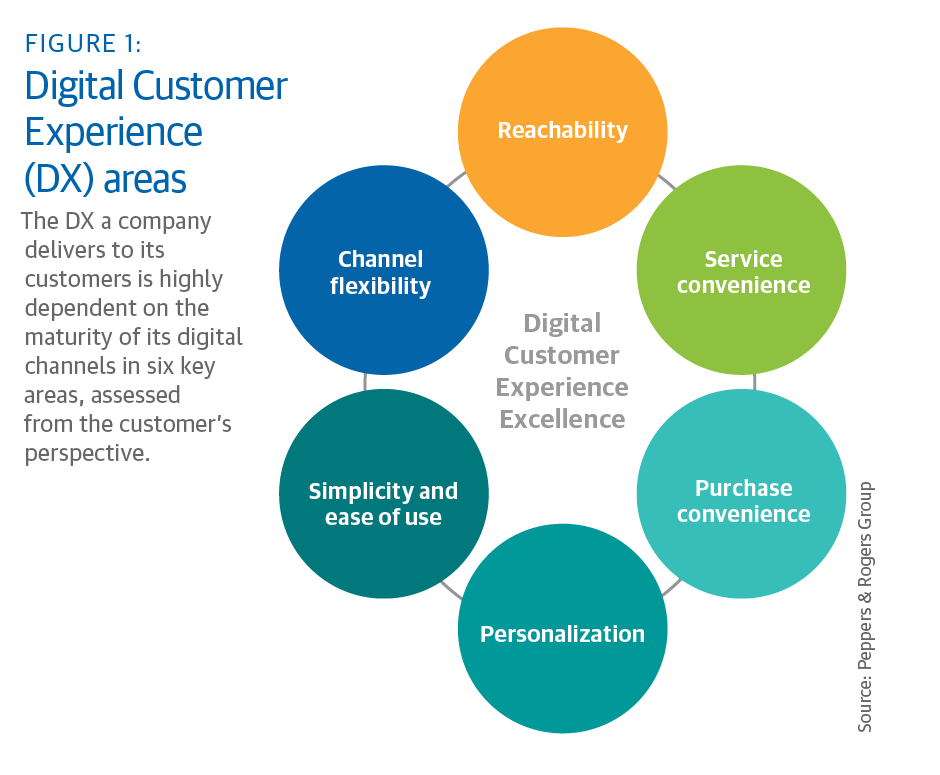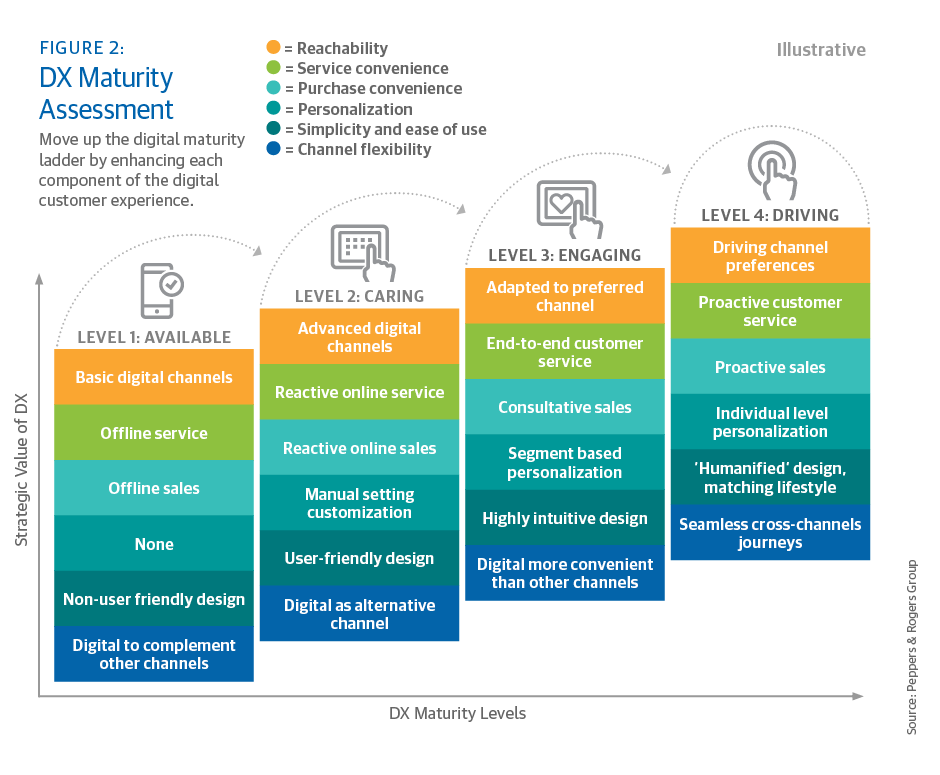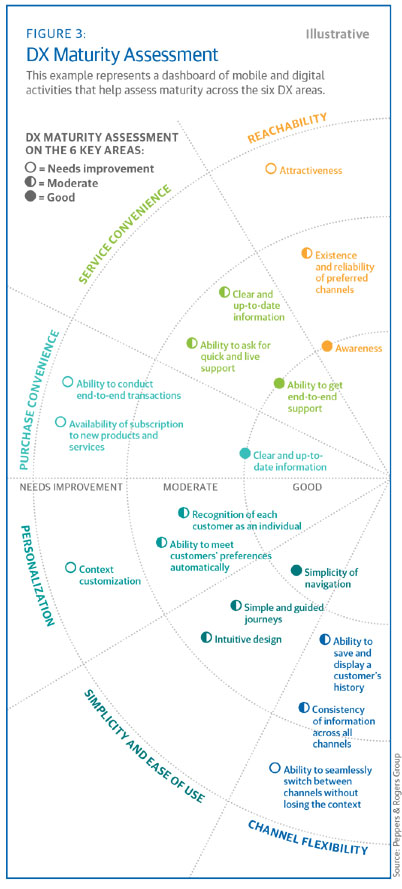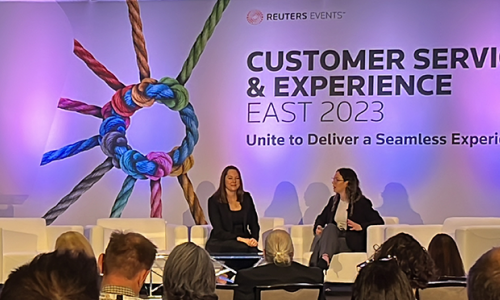The digital customer reality is upon us. Over the past few years, there has been the emergence of “mobile-only” customers who prefer digital and mobile tools. The line between the online and offline worlds continues to blur more every day with mobile banking and tools, virtual customer service, and robust shopping experiences. It’s nearly impossible to serve customers without employing digital channels.
The promise of an effective digital customer experience strategy (DX) is enticing to many companies, but the reality is that many are immature when it comes to digital customer experience strategy. A digital experience strategy requires brands to think differently about their customer engagement approach and identify how digital fits into the overall CX journey. Simply adding digital tools on top of marketing, sales, or service interactions is not sufficient. On their own, they do not take into account the customer perspective, and in some cases will add unwanted complexity to the business.
In this article we explore how incorporating digital CX strategy into a holistic digital transformation plan can help companies move closer to frictionless, omnichannel experiences. Specifically, we have found that companies can optimize processes and deliver great CX by improving in six key areas: (1) channel flexibility, (2) reachability, (3) service convenience, (4) purchase convenience, (5) simplicity, and (6) personalization. Read on to learn more about each of these key areas as well as customer experience management next steps to accelerate your digital transformation.
A holistic digital customer experience journey requires a defined CX strategy
With a frictionless experience, a customer can meet his need or solve his problem completely effortlessly in any channel, without having to jump through hoops or overcome obstacles. Obstacles are friction. No one has time for obstacles, digital or otherwise.
Our digital customer experience services team has found that digital CX excellence is directly linked to the extent to which companies excel in six key areas:
1. Channel Flexibility
- Ability to seamlessly switch between multiple channels without losing the context
- Consistency of information across all channels
- Ability to save and display a customer's history
2. Reachability
- Awareness
- Existence and reliability of preferred channels
3. Service Convenience
- Clear and up-to-date information
- Ability to ask for quick and live support
- Ability to get end-to-end support
4. Purchase Convenience
- Ability to conduct end-to-end transactions
- Availability of subscription to new products and services
- Clear and up-to-date information
5. Simplicity and ease of use
- Intuitive design
- Simple and guided journeys
- Simplicity of navigation
6. Personalization
- Context customization and personalized experiences
- Recognition of each customer as an individual
- Utilizing customer data to meet preferences automatically
The main areas of digital customer experience strategy
Delving deeper into each of the six areas, a DX maturity spectrum emerges to show how well-positioned a company’s digital customer experience strategy actually is. There are several levels of maturity through which a company moves before achieving the goal: a frictionless and highly competitive digital customer experience. We have developed a concrete digital experience maturity assessment framework, based on the six key areas, aimed to help a company better position their actual DX performance. A firm moves from being available to consumers on digital channels to caring, engaging, and finally driving a preferred digital lifestyle.
There are a number of ways to measure a company’s DX maturity. Reachability is assessed by measuring the existence and reliability of a customer’s preferred channel, plus consumer awareness and attractiveness. Service convenience measures how easy it is for consumers to be fully served digitally. Purchase convenience matches the service convenience metrics, along with how seamless the digital transaction process is. Personalization is measured based on recognition of customers as individuals. Simplicity assesses digital navigation and timeliness. And channel flexibility tracks how seamless it is for customers to switch channels.
Knowing where you are on the DX maturity ladder is very important to customer experience strategy. It is imperative to optimize digital interfaces and integrate them with other channels to create a truly omnichannel environment. Not only will it improve digital customer experiences, it will optimize your operations to allow greater efficiencies and save costs.
What strategy can be implemented to improve DX maturity?
There are a number of ways a company can move up the DX maturity ladder to create better CX. From a strategic perspective, digital customer experience management must become an executive priority and align with the larger corporate strategy in order to facilitate real improvements. From there, clear channel roles and responsibilities must be defined, along with how to migrate activities from traditional to digital channels.
Organizationally, we recommend creating a dedicated digital team who defines alignment and synergies with other relevant business units—marketing, sales, services, and other channels. The team must develop KPIs to drive organization and cultural mindset toward cx and digital transformation, and streamline operations to create efficiencies and eliminate redundancies. Where possible, automate current processes and design new ones with a customer focus.
And of course, measuring performance with big data and CX analytics is imperative. Use digital and social analytics such as Web stats, digital affinity, and micro-segmentation to track progress. Right-time analytics including churn prediction, and cross-sell/up-sell propensity will also allow companies to make the most of their DX activities. Effective omnichannel solutions must include a 360-degree view of customer interactions across all channels (digital interactions and traditional) to monitor channel preference, usage, and journeys. Much of this analysis can now occur in real time, via customer insights and digital experience platforms, giving executives actionable insight at the right moment. Digital tools like search engine optimization (SEO) and search engine marketing (SEM), community management, web, mobile app, social media, and digital advertising must be leveraged. And the design of any new DX program must be customer-centric and fit into the current CX journey.
Customer experience strategy: Putting it all together and next steps to improve digital CX
The concept of “digital” is on the minds of most business leaders, and effective digital customer experience management is crucial to accelerate your organizations digital transformation. As they make decisions about where to invest for the future, it’s imperative to incorporate a strong digital CX strategy. Digital experiences are becoming the primary type of experience for most consumers. Companies that can determine their organization’s maturity and implement a long-term customer experience plan will have an advantage over the competition. TTEC's CX consulting team can provide customer experience digital services to help you measure your current digital customer experience maturity level and roadmap a strategy for improvement. Our contact center outsourcing solutions also provide a cost effective way for brands to improve CX, accelerate digital transformation, and build operational efficiencies.
More digital customer experience best practices
We hope you enjoyed this article on customer experience strategy. Here our some additional resources from our CX digital services team.
Guide to Effortless Omnichannel CX: Omnichannel is essential to succeed in the digital age. Turning on channels or technology is simply not enough to win. Brands must understand the entire CX journey and enable effortless interactions across all digital touchpoints. This strategy guide provides customer experience roadmap principles and best practices so you can hit the right notes for effortless omnichannel CX.
The Ultimate CX Digital Transformation Workbook for Contact Centers: Achieving a value-based digital transformation in the contact center starts with a tactical cloud based CX strategy – one that’s rooted in an unbreakable alignment of business goals, IT strategy and customer needs. We've designed a 7-point digital planning workbook to help your company determine the digital customer experience technologies that are best for your business.
Five Essential Steps to Digital Transformation: When optimizing customer experience digital solutions, it is also beneficial to move from a channel-centric to a customer-centric operating model. While this may sound daunting, don't worry! In this strategy guide, we'll explain the five key steps to enable end-to-end digital transformation that improves CSAT, reduces cost, and increases revenue.
Customer Journey Maps as a CX Tool: Discover five key steps to help you understand the current state of the digital customer experience journey and create an ideal future state. In this strategy guide, we'll explain how measuring customer feedback helps you better understand the pain points your customers face, so that you can continue to improve the CX journey and increase customer loyalty
Contact Center Automation: Tools and Trends for the Decade Ahead: Technological advances in robotic process automation (RPA), AI, machine learning (ML), and live chat are literally changing the face of customer support. However, just because you can automate something in the contact center doesn’t mean you should. To know which tasks to turn over to artificial intelligence is a key aspect of digital customer experience strategy in the decade ahead. In this article, we explain the most important approach to successful contact center automation, outline some of the main types of contact center automation tools being implemented in contact centers, and discuss the benefits of an optimized balance between humans and AI in your CX automation approach.
CX Outsourcing: We equip clients with the facilities, people, processes, and modern omnichannel technologies that build value across every interaction on all channels. Whether onshore, offshore, nearshore, or at home with virtual software, we help our clients manage their front office and back office systems and create amazing customer experiences.












